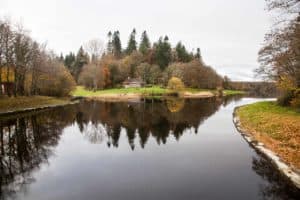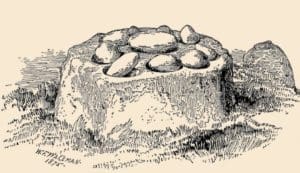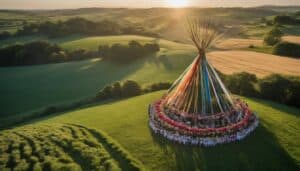Comparative Folklore: The Sidhe And Global Otherworldly Entities

Updated On: April 20, 2024 by Maha Yassin
In the vast tapestry of global folklore, few entities, like the Sidhe, the fairy folk of Irish mythology, capture the imagination. Steeped in ancient tales and mysticism, these otherworldly beings have counterparts in various cultures, each with unique characteristics and stories. Our exploration of these mystical figures unearths a rich cultural dialogue between civilizations, demonstrating how different societies interpret the elements of the unknown in remarkably similar ways.
Our journey takes us through the veil of the mundane to discover the enchanted realms of the Sidhe and their ilk. From the fairy mounds of Ireland, where the Sidhe are said to dwell, to the myriad otherworld entities found worldwide, each culture offers a unique window into the supernatural. These narratives, while diverse, share common threads that weave together the human experience with the supernatural, providing insight into our collective psyche and the universal themes of curiosity, caution, and respect for forces that lie beyond our understanding.
Unveiling the Sidhe: Origins and Mythology
In exploring the tapestry of Irish mythology, we uncover the Sidhe, beings of otherworldly grace and power. Their legacy is woven into the ancient land, offering us a glimpse into Ireland’s spiritual beliefs and cultural history.
The Ancient Roots of Irish Mythology
Our investigation into the Sidhe’s beginnings reveals roots that intertwine with the earliest strands of Irish culture and history. The Sidhe are often equated with the Tuatha Dé Danann, a fabled race of god-like figures who, according to myth, ruled Ireland before the arrival of humans. These ancient gods are deeply ingrained in the fabric of Irish mythology, and their tales have permeated through the ages to become a cornerstone of Celtic culture.
Sidhe in Celtic and Irish Folklore
Within Celtic and Irish folklore, the Sidhe are renowned as powerful spirits tied to the natural world, embodying the strengths and spirits of nature itself. These entities are depicted as residing within hidden mounds and realms across the Irish landscape, their presence felt but seldom seen. The Sidhe’s influence is far-reaching, with countless stories echoing their interactions with the mortal realm, from acts of generosity to those of subtle mischief.
The Power and Influence of the Sidhe
The Sidhe’s influence permeates Irish lore, encapsulating their enigmatic essence and supernatural abilities. They wield considerable power, with many tales attributing them with control over the elements and the fates of crops and livestock. The reverence shown towards these beings manifests in numerous customs and traditions designed to appease the Sidhe and avoid their oft-spoken wrath. They are not merely figments of imagination but integral components of the historical belief system that shape our understanding of Ireland’s past.
Our journey through the olden myths of Ireland illuminates the Sidhe’s significant role in Celtic mythology. By tracing their origins and impact, we appreciate the depth of our ancestors’ worldviews and the enduring resonance of these ancient narratives.
Examining Otherworld Entities Across Cultures
We’ll explore the astonishing variety of otherworld beings that feature prominently in global folklore, mythologies, and ancient cultural traditions.
A Comparative Study of Fairy-like Beings Globally
The myriad of creatures that occupy the otherworld realm in various cultures are often akin to the fairy folk of Celtic mythology. Irish folklore, for instance, speaks of the Aos Sí, a powerful supernatural race comparable to the fairies or fae. These beings are deeply interconnected with nature and are often thought to reside in fairy mounds, one of the most famous being the Sidhe. Similarly, in Scandinavia, elves are viewed as magical entities with close ties to the earthly environment. At the same time, Slavic folklore describes domovoi as guardian spirits with a protective role over the home.
Across the world, in Japan, entities like the kami, spirits revered in the Shinto religion, share traits with Western ideas of deities and fairies, being considered both divine and a part of nature itself. Meanwhile, in indigenous North American cultures, spirit beings can often reflect the characteristics of gods and fairies – nature spirits that interact with humanity, sometimes benevolently and sometimes trickster-like.
Supernatural Beings and Ancient Gods: A Cross-Culture Perspective
A leap from fairy-like creatures to the domain of gods and goddesses unveils a spectrum of otherworldly entities worshipped or feared across various cultures. Ancient Greek mythology is replete with a pantheon of deities, such as Zeus and Athena, who governed different aspects of the world and human life. In contrast, the Norse gods like Odin and Thor were also attributed with supernatural qualities and connection to the other realms.
Further East, the complex Hindu tradition boasts a multitude of gods and goddesses, each with vast mythologies and a strong presence in both the physical and supernatural realms. Egypt’s ancient civilisation venerated various deities associated with aspects of life and the afterlife, believed to exist in realms beyond human understanding. These deities influenced their followers’ lives, dictating the ebb and flow of the Nile as well as the outcomes of battles and harvests.
In these traditions, whether defined as fairies, spirits, or gods, the entities linked to the otherworld serve crucial roles within their respective cultures. They explain natural phenomena and embody the morals, values, and issues human societies grapple with. The global depiction of such supernatural beings – from the Sidhe to elves to deity figures – illustrates a rich, shared human fascination with the realms beyond our own.
Fairy Folklore Traditions
In exploring fairy folklore traditions, we unveil a tapestry of customs and narratives deeply interwoven with the fabric of cultural heritage.
Rituals and Observances
Throughout Ireland, Samhain marks a pivotal annual observance. As the veil between worlds grows thin, we honour the Aos Sí, or ‘people of the mounds’, also known as the Sidhe. The ancient tradition dictates leaving offerings such as food or milk outside homes, a practice thought to ensure peace with these unseen beings. In the past, it was common for children and adults alike to dress in disguise to evade the attention of mischievous spirits during this liminal time.
Legends and Storytelling in Tradition
The canvas of Irish lore is rich with tales spun from the old language and carried through generations by meticulous storytelling. Legends of the Sidhe, like those found in the Irish Pagan School, recount enchantments cast upon unwary travellers and secret dances under the moon. Such stories serve as entertainment and moral lessons, reminding us of our connection to the natural world and the mysterious inhabitants of the Otherworld. The old Irish legends have been kept alive partly by the reverence for customs and the art of orally passing down these captivating traditions.
Sacred Spaces: Fairy Mounds and Dwellings

In exploring the fairy realm‘s geography, we’ll delve into the cultural importance of sacred sites and the fascinating nature of fairy dwellings.
The Significance of Mounds in Fairy Culture
Throughout various cultures, fairy mounds—known as sí or fairy forts—hold a revered place. These mounds and hills are often seen as portals to the fairy realm, gateways between our world and a hidden, otherworldly domain. They are steeped in legend, where the veil between our reality and the fairies’ is thinnest. Particularly in Irish folklore, these sacred sites are not merely aspects of nature but are imbued with significant cultural and spiritual value. It is believed that disturbing these mounds can bring about misfortune, as they are the dwellings of the Sidhe, the earth’s ancient guardians.
Exploring the Dwellings of the Fairy Realm
The dwellings of the fairy mounds are more than mere mythology; they evoke a sense of enchantment and respect for the land. Characteristically located in areas of untouched natural beauty—underground, within dense forests, or alongside tranquil lakes—these sites are considered sacred spaces where the Sidhe reside. Accounts describe the fairy dwellings as lavish and intricate, reflecting the fairy mound’s external natural elegance. These dwellings are thought to simultaneously exist within our world and beyond it, in a dimension where the fairies live in close connection with the forces of nature, celebrating and preserving the energy and spirit of the Earth.
Discovering more about the traditions and beliefs surrounding the fairy mounds can be a mesmerising journey into the world of folklore. To see these mythical sacred sites through the lens of those who hold them dear, visit The Irish Pagan School, where one can learn about the intrinsic connection between the Sidhe and the ancient monuments of Ireland. For a broader understanding of the etymology and history of the Aos Sí, the Otherworldly mounds or hills, Wikipedia provides a succinct overview. Skilled in moving quickly through the air and changing shape, the Sidhe and their enchanting abodes remain a captivating topic within Celtic folklore, as detailed by articles on the Sidhe.
Cultural Depictions and Artistic Representations
In exploring the mythical Sidhe from Irish folklore, we encounter a rich tapestry of cultural depictions and artistic representations, reflecting the profound legacy these beings have on our artistic and cultural heritage.
Fairies in Visual Arts
The Sidhe, or fairy folk, have been a central subject in the visual arts, capturing the imaginative essence of Irish mythology. Paintings like John Duncan’s Aos Sí, depict these mythical creatures in a way that merges the ethereal with the real, often set against the verdant landscapes of Ireland. These artworks reflect the artist’s fascination with the myth and contribute to the country’s visual heritage.
Literary Works Featuring the Sidhe
Irish literature has been particularly enriched by tales of the Sidhe, with books such as W.B. Yeats‘s collection of Irish fairy and folk tales weaving narratives deeply rooted in the Irish cultural psyche. The depiction of the Sidhe in literature ranges from the sorrowful to the mischievous, intertwining with the lives of mortals in ways that reflect the complexities of our human nature. Such literary works are not mere stories; they serve as a cultural bridge, connecting us to the Ireland of yesteryears and its timeless traditions.
Nature and Elements of the Sidhe

Within the tapestry of Irish folklore, the Sidhe hold a revered place, intricately linked to the land, its elements, and the cyclical rhythm of the seasons. Their nature embodies a profound connection to the supernatural realm, marked by enchanting allure and formidable powers.
The Connection with Nature and the Seasons
The Sidhe are intrinsically woven into Ireland’s natural world. They are the guardians of nature’s sanctity, deeply intertwined with the verdant meadows, lush forests, and mystical fairy mounds dotting the Irish countryside. The progression of seasons markedly influences the Sidhe, from the rejuvenation that spring ushers in to the withdrawal and seclusion associated with winter, reflecting their deep symbiosis with the land’s vitality and hibernation.
Elemental Powers and Supernatural Abilities
Endowed with elemental powers, the Sidhe command facets of nature such as water, earth, and weather patterns, often mirrored by the tempests they are believed to conjure or the calm they can bestow on a tranquil sea. These beings are thought to possess a vast range of supernatural abilities, varying from enchanting mortals with their music and appearance to wielding control over natural forces. Their prowess is not just limited to influencing the elements but extends to the very essence of what they represent, from the nurturing waters of rivers and springs to the very soil that feeds the nation.
In addressing their nature and elements, we touch on the very essence of the Sidhe, beings who infuse the fabric of Irish mythology with power, mystery, and a connection to the world that remains unseen yet palpably present in every silent glen and ancient stone circle.
Encounters and Experiences with the Sidhe
In exploring the Sidhe, we’ll discuss the long-held traditions regarding interactions with these mystical beings and the personal testimonies that give weight to their existence in folklore.
Warnings and Respectful Practices
The Aos Sí are treated with great respect and caution in traditional lore. It is thought that disturbing their dwellings could bring about their wrath. As such, some specific offerings and practices are encouraged to maintain harmony with them. For instance, it’s customary to leave a portion of one’s crops untouched as a sign of respect, and during certain festivals, offerings of milk or bread might be made to appease these spirits.
Cautionary tales abound regarding the consequences of disrespecting the Sidhe, and wisdom from these narratives is often passed down through generations. The Sidhe are frequently considered guardians of natural places and thus bless those who treat the land and its mystical inhabitants with reverence.
Personal Accounts and Shared Experiences
There are numerous stories of encounters with the Sidhe throughout Ireland and Scotland. These range from sightings of ethereal figures in the landscape to more personal accounts of communication or interference by these beings in the lives of humans.
- For example:
- A farmer who inadvertently built upon a fairy path might find their luck souring.
- Those who have experienced a stroke of unexplained good fortune may attribute it to the blessings of the Sidhe.
Shared experiences often involve moments of unexplained phenomena, such as mysterious music emanating from sidhe-mounds or the appearance of intricate fairy rings in fields. Personal accounts often emphasise the importance of respect and the careful observance of traditions to avoid any ill effects.
Cultural Persistence and Modern Interpretations
As entities with a rich heritage in Irish folklore, the Sidhe have transcended the ages, finding their place in contemporary society and media. Their perennial presence underscores a cultural continuity that bridges ancient legend with modern narrative forms.
The Sidhe in Modern Media and Entertainment
The allure of the Sidhe has not diminished with time; rather, it has adapted to the evolving palette of modern culture. In movies and television, these otherworldly beings have been portrayed with a blend of traditional characteristics and contemporary twists, reflecting their enduring legacy and sustained influence. For instance, the depiction of these fair folk in fantasy series echoes the deep-seated human fascination with myth and magic that transcends the boundaries of age and time.
Relevance of Fairy Folklore in Contemporary Society
Fairy folklore maintains its relevance in contemporary society through entertainment and as a lens to view and critique modern social dynamics. The Sidhe and similar ethereal creatures often serve as metaphors for ecological concerns and societal issues, mirroring our world’s complexities. This transformative power of folklore to comment on modern culture emphasises its vibrant role in today’s discourses, ensuring these stories resonate with new generations and retain their position within our shared cultural framework.
Rules and Customs of Interaction

In folklore, the Sidhe and otherworldly beings require careful consideration in interaction. We must comprehend the gravity of tradition and the necessity for respect.
Understanding the Importance of Tradition and Respect
Traditional narratives hold that the Sidhe, often equated with the Aes Sí, command respect due to their reputed origins and powers. They are closely intertwined with the Irish landscape, inhabiting locations marked by an aura of the ancient and mystical. One must acknowledge the weight of tradition when approaching these beings, as cultural customs dictate respect for their presence and influence.
Traditions to consider:
- Acknowledging the Sidhe presence: Always recognise their space, especially in natural settings known to be their haunts.
- Avoiding offence: Refrain from disrespecting the Sidhe or their dwelling places, often considered sacrosanct.
Guidelines for Human-Sidhe Engagement
Engaging with the Sidhe requires adherence to established rules and customs to avoid repercussions. Offerings or gifts are traditionally used to appease or gain favour. Warning tales from folklore often guide what actions to avoid, instilling caution in human interactions with the Sidhe.
Customary guidelines:
- Leave gifts: Small offerings like bowls of milk or butter left outside homes can express goodwill.
- Respect privacy: Cross not into the uninvited territories of the Sidhe to maintain peaceful coexistence.
- Heed the warning: Disturbing Sidhe mounds or participating in activities on certain festival days is frowned upon.
In adhering to these customs, interactions with the Sidhe and comparable entities are navigated with caution and reverence, ensuring a harmonious relationship between humans and the spectral beings of folklore.
Irish Language and the Names of the Sidhe
Understanding the terminology related to the Sidhe is crucial in our exploration of Irish folklore. The names and terms in the Irish language offer a unique perspective and connect deeply with the transcendent qualities attributed to these otherworldly beings.
Etymology of Sidhe and Other Terms
The word Sidhe (pronounced “shee”) originates from the Old Irish term síd, referring to the mounds or hills where these fairy folk are believed to reside. Over time, Sidhe has evolved to encompass the entities themselves. For example, Daoine Sidhe translates to “people of the mounds,” referring to the fairies in a collective sense.
In the same vein, a Bean Sidhe, known in English as banshee, is a singular term signifying a “woman of the fairy mound,” often regarded as a harbinger of death with her mournful wails. The affectionate term Na Daoine Maithe, meaning “the good people,” is used to avoid offence, illustrating the Irish’s respect for these entities.
The Role of the Irish Language in Folk Tales
Our language is a vessel for our stories, and in Irish folklore, the linguistic nuances offer layers of meaning and context. The use of specific terms like Aos Sí, The Other Crowd, and The Good Neighbours reflect a mixture of deference and an attempt to avoid drawing the attention of such powerful beings.
The sidh, or Aos Sí, is an integral concept to many folk tales, embodying the essence of the enchanted realms they inhabit. Language plays a pivotal role in conveying the interconnectedness of the Sidhe with the natural world and the cultural identity of Ireland itself. By continuing to use these terms in contemporary tales, we honour this linguistic heritage and carry it forward for future generations to treasure.
Folk Beliefs and the Supernatural

In this section, we’ll explore how the folk beliefs surrounding the Sidhe and its interaction with mortal perceptions and religious interpretations weave a tapestry of supernatural narratives.
Mortal Perceptions of the Sidhe
The Sidhe, often known as the Aos Sí, are a race of supernatural beings in Celtic mythology. Folklore posits them as immortal entities residing in a parallel world. They are sometimes equated with what we call fairies or elves and are considered remnants of the pagan gods, now dwelling in the Otherworld. Our ancestors would warn against disrespecting the Sidhe, as they were believed to have powers over the welfare of humans and the dead. One of the most recognizable of the Sidhe is the banshee, whose mournful wail is an omen of death. These traditional beliefs shape simple tales and underscore a profound respect for forces beyond our understanding.
The Intersection of Paganism and Christianity
The tapestry of Irish folklore intricately stitches the threads of paganism and Christianity. During the early Christianisation of Ireland, many pagan beliefs were either assimilated or reframed within a Christian context. The Sidhe, for example, were often demoted from their status as deities to that of fallen angels or spirits linked to the fae. This complex interweaving reflects how Irish folk beliefs transformed, ensuring the survival of older pagan narratives in a new religious landscape. This fascinating transition reveals the resilience of cultural identity and showcases our innate desire to keep the essence of our ancestral beliefs alive, even when adapting to new ideologies.
Frequently Asked Questions

In this section, we uncover specific nuances of the Sidhe and their representation in folklore, addressing common curiosities about these enigmatic otherworldly beings.
What distinguishes the Sidhe from other beings in otherworld folklore?
The Sidhe imbued with a distinct mystique in Irish folklore, are often considered closer to deities than to the common perceptions of fairies. Their traits include an ethereal presence and connection to ancient Irish gods, setting them apart from other supernatural beings.
Can you enumerate the various types of Sidhe in Irish mythology?
In Irish mythology, the Sidhe encompass figures such as the Aos Sí, Bean Sídhe, and the Sluagh Sídhe, each with unique characteristics and societal roles within the otherworld.
What are the characteristics and roles of the Daoine Sidhe in folklore?
The Daoine Sidhe are revered for their beauty and are often depicted as protectors of nature and wise beings interacting with humans, serving as a bridge between the natural and supernatural realms.
How does the concept of the Leanan Sidhe differ from other Sidhe entities?
The Leanan Sidhe is portrayed as a muse who bestows inspiration to artists at the price of their life force, an entity distinctly different from other Sidhe who are not usually associated with such a dangerous exchange.
Is there a distinction between the Aos Sidhe and the Tuatha Dé Danann?
The Aos Sidhe are descendants of the Tuatha Dé Danann, an ancient tribe of gods. While the Tuatha represent a former pantheon, the Aos Sidhe are seen as less divine and more connected to the earth and its energies.
In what ways are the Sidhe represented in comparative folklore studies?
Comparative folklore studies often highlight the Sidhe as emblematic of Irish culture. They compare their societal structures and roles to those of otherworldly beings across various mythologies, illuminating the shared motifs and distinct differences among cultures.






